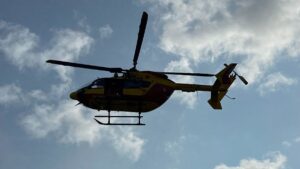
Rome, November 26 (Adnkronos) – The Sanpellegrino Group renews its commitment to biodiversity by presenting the results of the initiatives developed over the years at the Acqua Panna plantation and the wetland redevelopment project carried out at the Gabbianello Oasis in response to the real needs of society.
Thanks to collaboration with Federparchi, the Scuola Superiore Sant’Anna of Pisa, the University of Pisa and the University of Florence, since 2020 the company has strengthened the biodiversity of its 1,300 hectare plantation in Scarperia, in Mugello, where the Acqua Panna flows. Sanpellegrino has also enhanced its forest heritage, combining the objectives of protecting natural habitats and climate mitigation – explained Sanpellegrino in a note – Through the flora and fauna census carried out in this area characterized by 88% natural habitat, it was discovered that it is an ideal place to host 121 species of vertebrates and plants, 66 species of birds, various types of orchids and several species of amphibians of conservation interest. Of these, 34 are threatened according to the European Red List. The presence of species of particular ecological value has also been confirmed at the site, such as the Italian crested newt and the smooth newt.
In collaboration with the University of Pisa, the company has also developed a 150-hectare agroforestry plan, so far planting around 2,750 native plants on 23 hectares, including oak, hornbeam, hawthorn, hazelnut, wild cherry and elderberry. It has also created an ecological corridor about 6 kilometers long to increase the availability of food and shelter for migratory birds along the Europe-Africa route. The species also includes the feral dove, whose presence is declining across Europe due to habitat fragmentation, loss of hedgerows and seed scarcity, resulting in it being on the IUCN red list as ‘vulnerable’ at European level.
At the same time, Sanpellegrino aims to encourage the presence of pollinators, amphibians and orchids, which are important indicators of habitat quality and valuable for the environment. A Bee Hotel has been installed on the Villa Panna estate and flower fields have been planted for pollinators – bees and diurnal butterflies – the true ‘custodians’ of biodiversity and water resources. Digital technology-based monitoring has been active since 2024, detecting an increase in pollinator activity – from 781 to 3,713 individuals – along with an increase in observed species and improved habitat suitability indicators.
Sanpellegrino also presented the wetland regeneration project of the Gabbianello Oasis, located in the municipality of Barberino di Mugello and recognized as a Protected Natural Area of Local Interest by the Tuscany Region. In recent years, the Oasis, which covers an area of 25 hectares and 8 hectares of which are ponds, has been affected by climate change. To respond to the needs of local communities, the Sanpellegrino Group, together with the Municipality of Barberino di Mugello and technical partner Etifor, carried out hydrological and ecosystem redevelopment. In fact, the intervention involves expanding the flood area up to 40% wider than the initial situation, efficient water withdrawal from the Tavaiano stream, sediment control, reforestation interventions and the creation of paths and observation points for responsible use.
The project is accompanied by targeted interventions to protect amphibians and avifauna. In fact, the Oasis represents a fundamental stopping point along the Tyrrhenian migration route and is home to an extremely rich biodiversity: research carried out by the University of Florence recorded 91 species of birds, with 113 pairs of storks and many amphibians, including the great crested newt.
“Protecting the territories where our mineral waters flow has always been an integral part of our commitment, but today protecting biodiversity, threatened by climate change, requires greater efforts. Therefore, we continue to adopt a scientific approach, working together with our partners to regenerate forests, create ecological corridors, expand wetlands and support important species such as pollinators, amphibians and migratory birds – says Ilenia Ruggeri, general director of the Sanpellegrino Group – We aim to create a system, with the institutions and realities of the territories in which we are present, an experience that starting in Tenuta di Panna, to jointly build new partnerships aimed at developing innovative solutions to address local challenges, an example of which is the intervention on Oasis Gabbianello, which allows us to take this model beyond our Estate”.
“The collaboration with the Sanpellegrino Group shows how profitable synergies can be achieved between the world of sustainable entrepreneurship and ecosystem protection – says Lidia Bai, member of the Federparchi Board of Directors – The project aims to enhance areas of biodiversity excellence, from the BeeHotel to agroforestry interventions. The synergy between sustainable development and nature conservation is proving to be an indispensable tool to take a step forward in the protection of nature, communities and territories”.
“The agroforestry project in Tenuta di Panna aims to increase carbon sequestration through storage in wood tissue and to support biodiversity through the creation of ecological corridors and mini-habitats around plants – underlined Matteo Finocchi from the University of Pisa – This initiative represents a sustainable management model capable of increasing ecosystem resilience and generating environmental benefits, contributing to the development of innovative and responsible agricultural practices and promoting a shared vision in land protection”.
“With the Gabbianello Oasis project we have the opportunity to measure in detail the hydrometeorological variables of an artificial wetland that are useful for understanding the hydrological mechanisms that regulate water exchange – explains Daniele Penna, professor of Forest Hydrology at the University of Florence who, together with colleagues Federico Preti, Andrea Dani and Matteo Nigro, follows the project at the Gabbianello Oasis – Experimental monitoring activities are essential to measure and support management intervention decisions in complex transitional ecosystems between aquatic and terrestrial systems”.





